| Femmes Fatales | Oct 2 2021 |

This frolic has been sponsored by Off! bug repellent and Nasonex hay fever tablets.
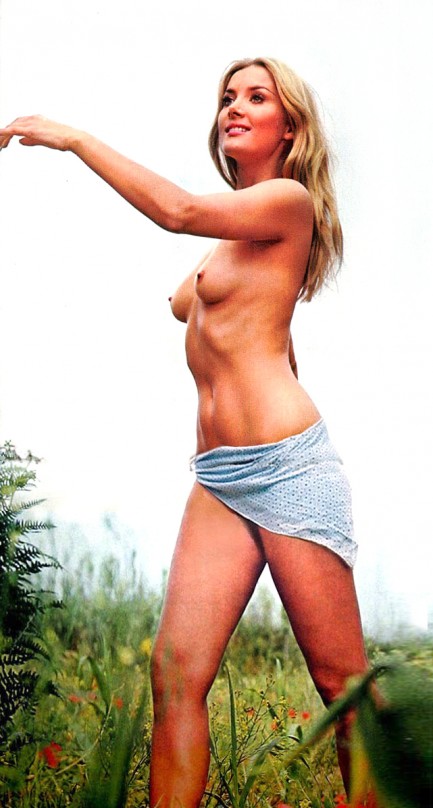
In this centerfold image from the Belgian magazine Ciné-Revue published in September 1972, Barbara Bouchet finds herself in a field of wildflowers and high grasses, and does what comes naturally—sneezes like a maniac until the medication kicks in. Then she frolics, and what a lovely frolic it is. We've featured Bouchet before, which means you already know she's a famously beautiful model-turned-actress who appeared in films like Non si sevizia un paperino, aka Don't Torture a Duckling, Gangs of New York, Casino Royale, and television's Star Trek. Also—and we didn't mention this the other times we wrote about her—she's another celeb who benefitted from a name change. She was born in 1943 in Sudentenland, a part of Czechoslovakia that was occupied by Germany at the time, and grew up as Bärbel Gutscher. That name simply doesn't roll off the tongue, so when she went to Hollywood she chose something that sounded French and the rest is history. These days she lives in Rome, where she still occasionally acts, though probably does a bit less frolicking. See a couple more shots of her here and here.
| Vintage Pulp | Sep 2 2020 |

The deeper you go into this casino the wilder it gets.
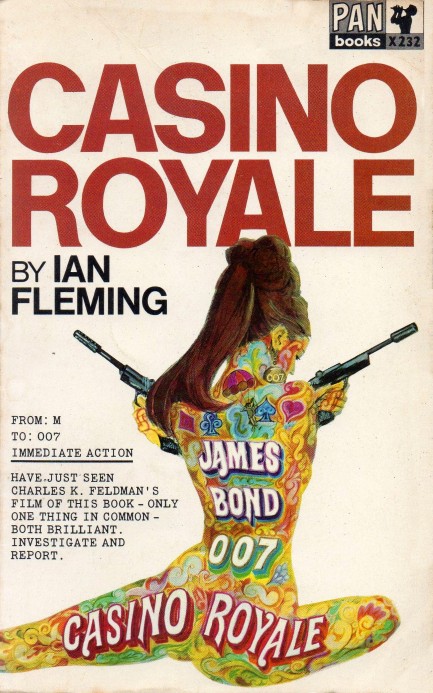
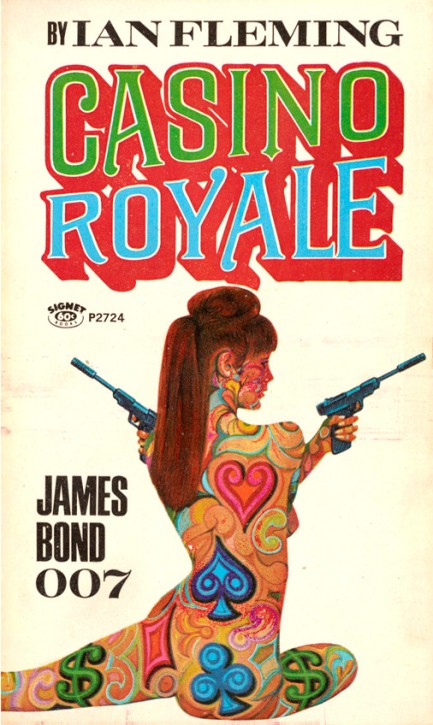
Today we're circling back to James Bond—as we do every so often—to highlight these movie tie-in editions of Ian Fleming's Casino Royale. The movie these are tied into is not the 1963 original with Sean Connery, but the 1967 screwball version with David Niven as Bond and Woody Allen as Bond's nephew Jimmy Bond. If you haven't seen it, just know that it was terribly reviewed, with Time magazine calling it an “an incoherent and vulgar vaudeville.” These covers are derived from the Robert McGinnis Casino Royale movie poster, which is an all-time classic. McGinnis created two versions of the poster—one with text and one without, with the painted patterns on the female figure varying slightly. You see both of those below.
The paperback was published by both Great Pan and Signet, and the cover art was different for the two versions. The Great Pan version at top is McGinnis's unaltered work, but the Signet version just above was painted by an imitator, we're almost certain. We'd hoped to answer this for sure by visiting one of the numerous Bond blogs out there, but none of them have really discussed the difference between the 1967 paperback covers. That leaves it up to us, so we're going to say definitively that the Great Pan version was not painted by McGinnis. Whoever the artist was, they did a nice job channeling the original piece, even if the execution is at a much simpler level.
Moving back to the posters, if you scroll down you'll see that we decided to focus on the details of the textless version to give you a close look at McGinnis's detailed work. The deeper you go the more you see—dice, poker chips, glittery earrings, actor portraits, and more. If you had a huge lithograph of this on your wall and a tab of acid on your tongue, an entire weekend would slip past before you moved again. This is possibly the best work from a paperback and movie artist considered to be a grandmaster, one the greatest ever to put brush to canvas. If anyone out there can tell us for sure who painted the Signet paperback—or whether it is indeed McGinnis—feel free to contact us.
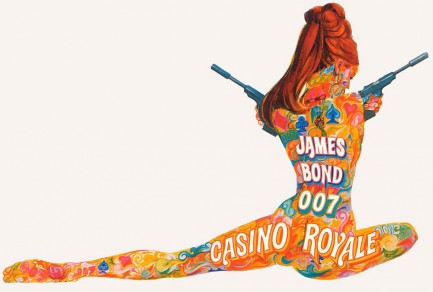

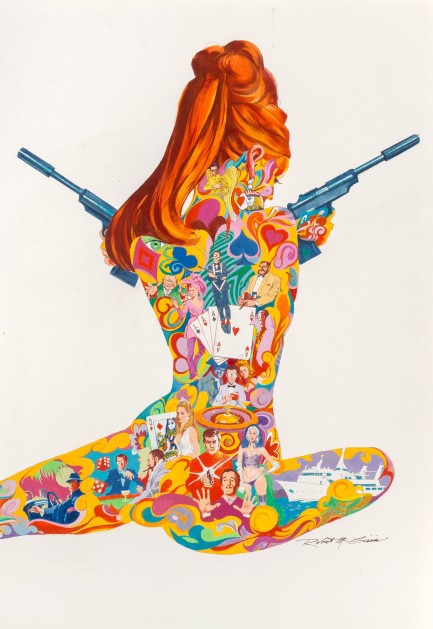
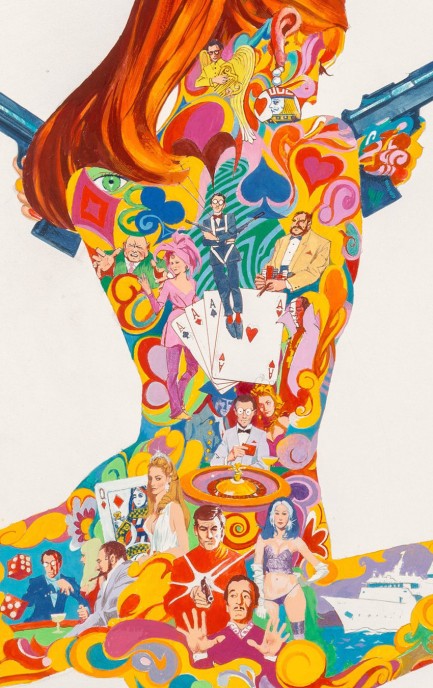
| Femmes Fatales | Jun 30 2020 |

When she tells someone to sleep well she means forever.
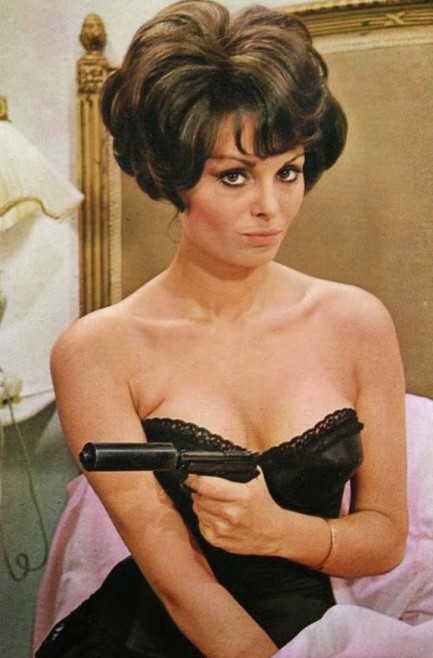
Above, a colorized shot of Israeli actress Daliah Lavi in character as Princess Natasha Romanova in 1966's The Spy with a Cold Nose, which as you can probably guess is about a dog turned into a spy. Silly of course, but this was during the heyday of spy spoofs. In fact, Lavi was in several others—Some Girls Do, Casino Royale, Schüsse im 3/4 Takt, aka Operation Solo, and The Silencers. All were ridiculous. There's nothing ridiculous about Lavi, though. She looks ready to kill in her black lingerie.
| Femmes Fatales | Jun 17 2020 |

James Bond's daughter leaves the Soviets shaken and stirred.
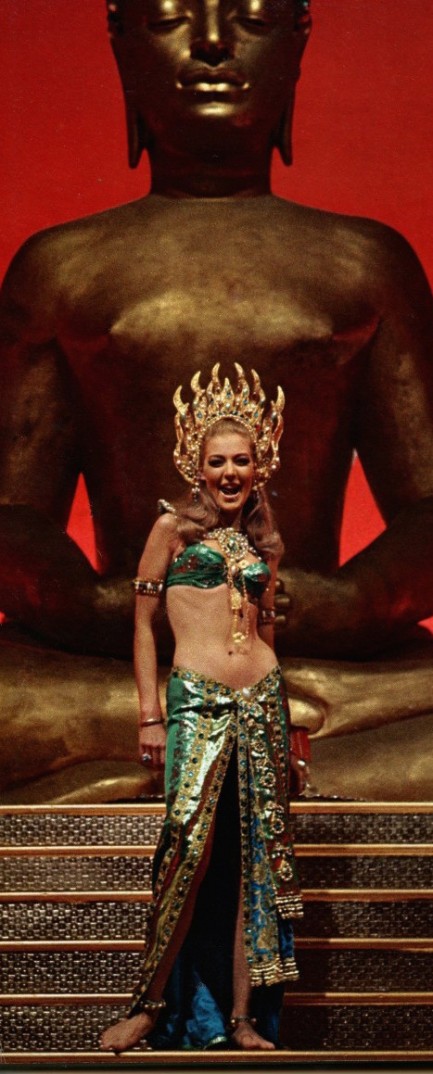
The 1967 James Bond spoof Casino Royale was a box office disaster, but it had its moments. London born actress Joanna Pettet, playing Mata Bond, estranged daughter of Mata Hari and Sir James Bond (David Niven), performed an eye-catching, Buddhist-themed dance number in a faux temple that must have cost a huge chunk of the movie's budget. We don't know how actual Buddhists feel about the bit, but it looks like Pettet had a laugh or two. In the film she's sent to take on SMERSH, the Soviet spy agency that appeared in fictionalized form in Ian Fleming's Bond novels. Pettet appeared in a handful of other films, but her career mostly comprised television roles on shows such as The Fugitive and Night Gallery. Her Mata Bond dance is short but probably worth a look. You can see it while the link lasts here.
| Femmes Fatales | May 16 2019 |

Bisset holds all the cards.
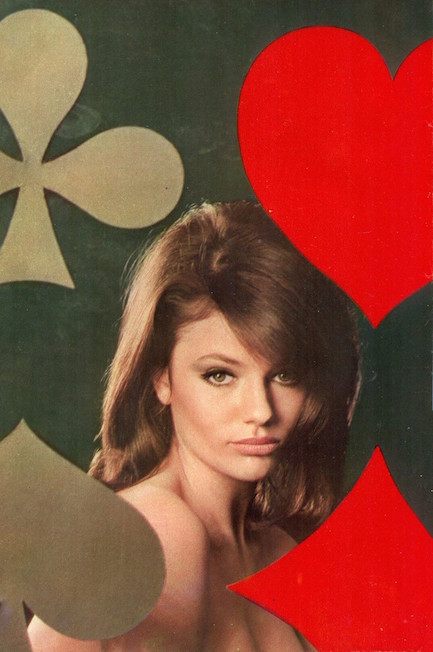
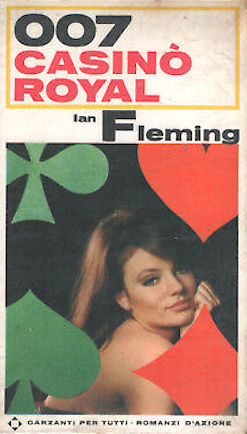 English actress Jacqueline Bisset peeks out from behind the suits of a card deck in this striking promo image made sometime during the late 1960s. A different photo from the session was used for the cover of Italian publisher Garzanti's 1970 release of 007 Casinò royal, which you see here as well. Bisset was born as Winifred (ouch!) Bisset in 1944 and made a name for herself in such impactful films as Bullitt, Murder on the Orient Express, The Deep, and Casino Royale. You could include efforts like Under the Volcano, The Man from Acapulco, The Life and Times of Judge Roy Bean, and Two for the Road in the aforementioned list. All told, Bisset seems a bit under-appreciated considering her filmography, but not by us.
English actress Jacqueline Bisset peeks out from behind the suits of a card deck in this striking promo image made sometime during the late 1960s. A different photo from the session was used for the cover of Italian publisher Garzanti's 1970 release of 007 Casinò royal, which you see here as well. Bisset was born as Winifred (ouch!) Bisset in 1944 and made a name for herself in such impactful films as Bullitt, Murder on the Orient Express, The Deep, and Casino Royale. You could include efforts like Under the Volcano, The Man from Acapulco, The Life and Times of Judge Roy Bean, and Two for the Road in the aforementioned list. All told, Bisset seems a bit under-appreciated considering her filmography, but not by us.| Vintage Pulp | May 8 2019 |

Garzanti cover for Bond collection is absolutely favoloso.
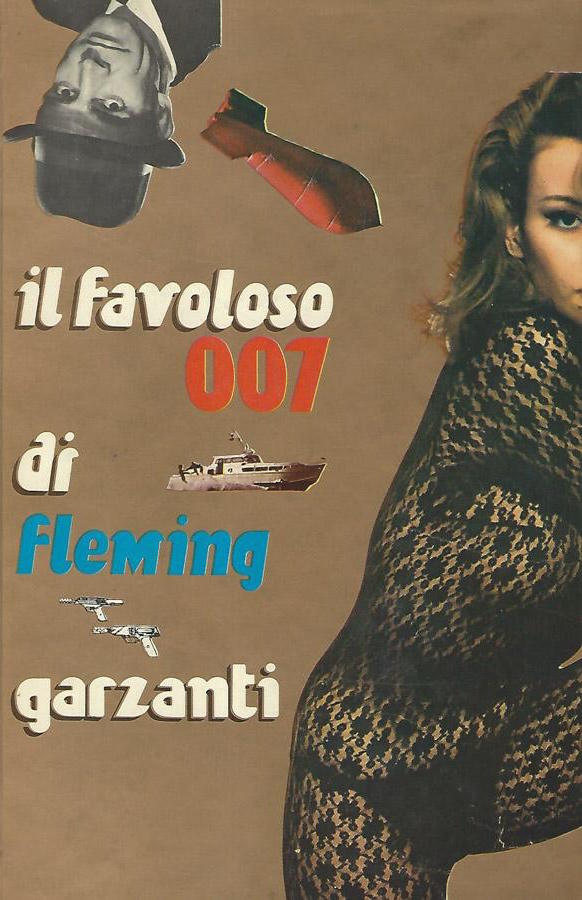
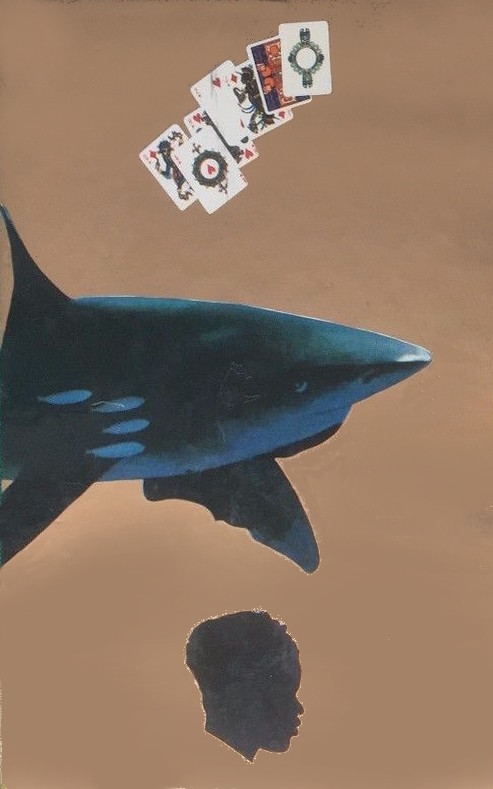 Here's a little something to add to the Ian Fleming bin. This is Il favoloso 007 di Fleming, published in Italy in 1973 by the Milan based company Garzanti. It's a compendium of the four James Bond novels Casinò Royal, Vivi e lascia morire, Il grande slam della morte, and Una cascata di diamanti, better known as Casino Royale, Live and Let Die, Moonraker, and Diamonds Are Forever. The cover for this is great, we think, and as a bonus the interior also contains some black and white photos.
Here's a little something to add to the Ian Fleming bin. This is Il favoloso 007 di Fleming, published in Italy in 1973 by the Milan based company Garzanti. It's a compendium of the four James Bond novels Casinò Royal, Vivi e lascia morire, Il grande slam della morte, and Una cascata di diamanti, better known as Casino Royale, Live and Let Die, Moonraker, and Diamonds Are Forever. The cover for this is great, we think, and as a bonus the interior also contains some black and white photos.But really, we were drawn to this because of the model and her fishnet bodysuit. Or is that lace? Doesn't matter. She's none other than Claudine Auger, aka Domino from 1965's Thunderball. Sean Connery gets a corner of the cover as well, and the rear is interesting too, with its shark and cards from To Live and Let Die. Technically, those cards should be tarots, but whatever, nice art anyway. And speaking of nice, we also located the photo used to make the cover, and you see that below too. Really cool collector's item, which we'd buy if we read Italian. But alas, that isn't one of our languages, so this one still languishes at auction.

| Femmes Fatales | Dec 21 2018 |

Screw it. My insurance is paid up. I'm going for a loop!
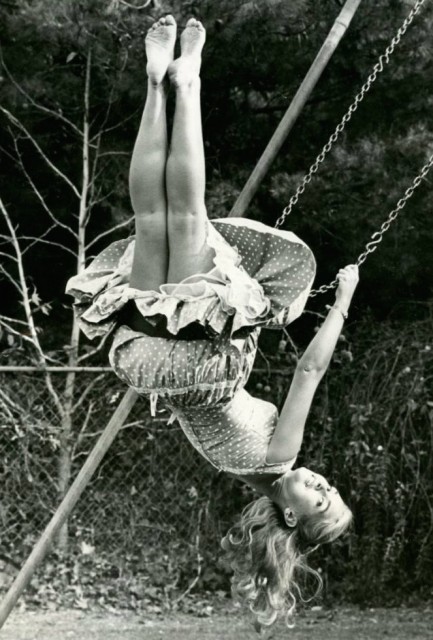
Above, a fun image of British actress Alexandra Bastedo, who was a television stalwart but did appear in such films as the 1967 James Bond spoof Casino Royale. We don't have a date on this photo, but it was probably made around 1965.
| Vintage Pulp | Apr 19 2018 |

Bond is born in Ian Fleming's 1953 Cold War thriller.
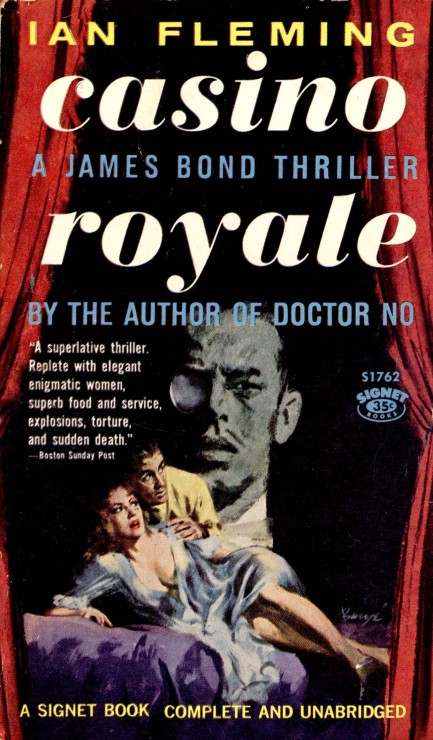
We've read a few Bond novels, but not his debut in 1953's Casino Royale. When it comes to secondhand bookstores and yard sales you read what you find. But we decided to finally make a deliberate effort to go back to the beginning with an edition from Signet, which appeared in 1960 with Barye Phillips cover art. The debuts of franchise characters leave room for continuing adventures by design but we've never read a book that was so deliberately a prequel as Casino Royale. It's the essential novel for understanding Bond. You know the basics already: Cold War intrigue, opposing teams taking the field for a long struggle, a Soviet spy named La Chiffre who's dipped into funds not his and who hatches a desperate plan to restore them via the baccarat tables of a famous French casino, Bond dispatched to outplay him, break him, and ensure his downfall for stealing the money.
The book is fantastic from its opening, through its tremendously tense middle sections, and on to its brutal punchline of an ending. Bond is imperfect as both a spy and a man. He's sometimes kind, prone to sentiment, and philosophical about his work; he's also sexist, racist, and generally regressive. Casino Royale is designed to explain how the first three qualities were destroyed, making him a perfect spy. The latter three qualities remain. While in serious fiction many authors of the period were writing about racial equality and the essential sameness of people, Ian Fleming was declaring that Asians are terrible gamblers because as a race they lack resolve. None of this is a surprise because much is known about Fleming's personal views. Bond is an icon, but of a less enlightened era. We're readers, of ours. Yet we can meet on the page, and—with a tolerance Fleming never showed others—still manage to have a little fun.
The book is fantastic from its opening, through its tremendously tense middle sections, and on to its brutal punchline of an ending. Bond is imperfect as both a spy and a man. He's sometimes kind, prone to sentiment, and philosophical about his work; he's also sexist, racist, and generally regressive. Casino Royale is designed to explain how the first three qualities were destroyed, making him a perfect spy. The latter three qualities remain. While in serious fiction many authors of the period were writing about racial equality and the essential sameness of people, Ian Fleming was declaring that Asians are terrible gamblers because as a race they lack resolve. None of this is a surprise because much is known about Fleming's personal views. Bond is an icon, but of a less enlightened era. We're readers, of ours. Yet we can meet on the page, and—with a tolerance Fleming never showed others—still manage to have a little fun.
| Femmes Fatales | Dec 28 2017 |

She's ready to go anywhere her legs take her.
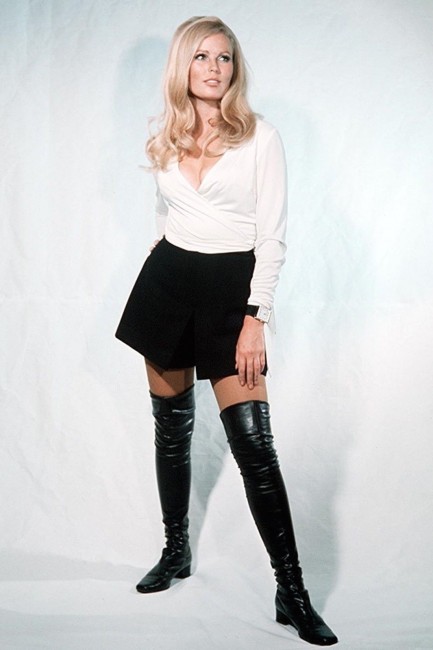
British actress Veronica Carlson's first screen role was an uncredited bit in Casino Royale, and her latest role is in 2018's upcoming House of the Gorgon. In between she became well known as a regular player in various Hammer Studios horror films. The above promo image was made when she appeared on the British television series The Saint. She looks a bit sinful, though, don't you think. Copyright 1969.
| Vintage Pulp | Apr 12 2015 |

Bond—James Bond. But Jimmy is fine. Some people call me Jim, Jimbo, J-Man, J.B. My mom calls me Jimminy Cricket. I’m cool with whatever.
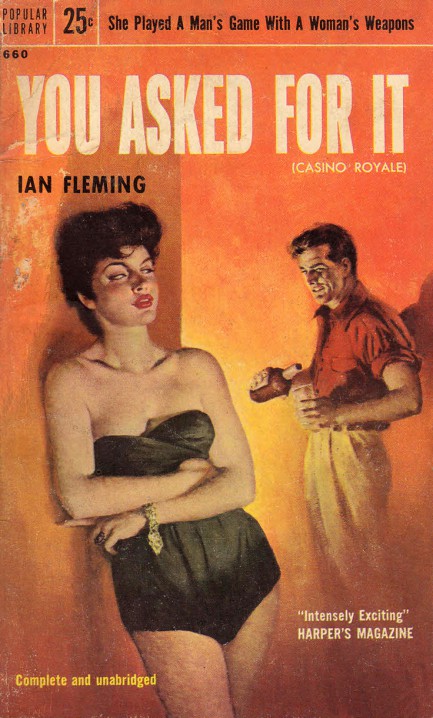
The story is well known—Popular Library insisted upon changing the title of Ian Fleming’s Casino Royale to what you see above. They even went so far as to call 007 “Jimmy Bond” on the rear cover blurb. Fleming retaliated by selling the U.S. publishing rights to Signet at first opportunity, leaving only a small run of very collectible copies of You Asked For It on the market. Fleming must have learned from the episode, though, that titles don’t really matter, because he later wrote Chitty-Chitty Bang Bang: The Magical Car. Anyway, You Asked for It appeared in 1955, with unsigned and uncredited cover art. The blog Killer Covers has a bit more info about the book here.





































































